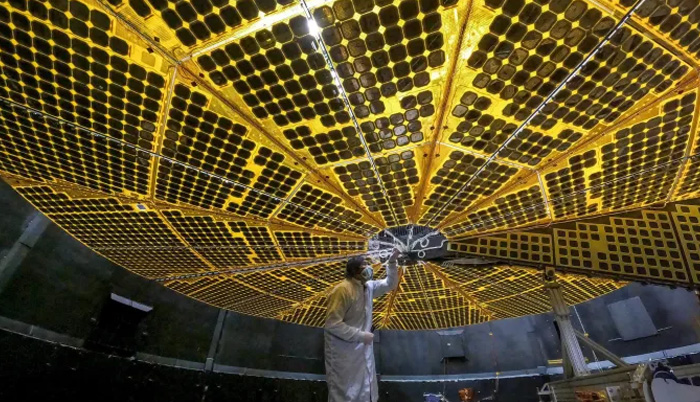![]() Home > Space & Science
Home > Space & Science
NASA Develops Ingenious Solution To Fix Its Troubled ‘Lucy’ Asteroid Explorer

NASA
![]() August 8th, 2022 | 12:23 PM |
August 8th, 2022 | 12:23 PM | ![]() 678 views
678 views
WASHINGTON, UNITED STATES
A solar array that failed to fully deploy is now 'stable enough to operate as needed.'
Last year, NASA launched the Lucy spacecraft designed to explore the Trojan asteroids trapped near Jupiter's Lagrange points. However, a problem arose just 12 hours after launch — one of the large solar arrays designed to generate power from an increasingly distant Sun had failed to fully deploy and latch. Now, NASA has announced that a team was able to troubleshoot the problem sufficiently for the mission to continue — thanks to several clever tricks.
Hours after the problem was first discovered, NASA pulled together an anomaly response team with members from the science mission lead Southwest Research Institute, NASA's Goddard Space Flight Center and the spacecraft's builder, Northrop Grumman.
Since there's no camera aimed at the solar arrays, the team had to figure out another way to find the problem. To that end, they fired the spacecraft's thrusters to measure any anomalous vibrations, and created a detailed model of the array's motor assembly to determine the array's rigidness. They finally figured out that a lanyard designed to pull the array open was probably snagged on its spool.
The team quickly honed in on two potential solutions. One was simply to use the array as it was, because it was still generating 90 percent of expected power. The other was to attempt to pull the lanyard harder by using the back-up deployment motor as well as the primary motor, hopefully allowing it to wind further and engage the latching mechanism.
Both motors were never designed to work at the same time, so the team modeled it to test out possible outcomes and potential ripple effects. After months of simulations, they decided to proceed with the two-motor option. They ran both the primary and backup solar deployment motors simultaneously seven times, and succeeded in further opening and tensioning the array.
Unfortunately, it didn't close enough to latch, but it's now "under substantially more tension, making it stable enough for the spacecraft to operate as needed for mission operations," NASA said. It's now "ready and able" to complete its next deadline, getting a boost from Earth's gravity in October 2022. It's scheduled to arrive at its first asteroid target in 2025.
Source:
courtesy of ENGADGET
by Steve Dent
If you have any stories or news that you would like to share with the global online community, please feel free to share it with us by contacting us directly at [email protected]